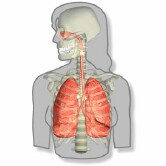
MONDAY, May 17 (HealthDay News) — The onset of serious lung disease in middle age may have genetic roots, even if the patient does not have a family history of such illnesses in their background, a new study has found.
The authors say a simple, noninvasive test might enable doctors to screen for genetic predispositions to serious lung disease before it develops, providing a window of opportunity to take preventive measures and minimize risk.
The finding, which is scheduled for presentation Monday at the American Thoracic Society conference in New Orleans, comes from researchers at the U.S. National Institute of Allergy and Infectious Diseases (NIAID).
“Earlier reports have indicated a correlation between certain non-tuberculous mycobacterial respiratory infections and specific gene abnormalities,” lead author Dr. Kenneth Olivier, a NIAID staff clinician, noted in a news release. “The results of this study confirm the correlation, and indicate the usefulness of simple testing in identifying these abnormalities, especially in an older population.”
The NIAID team analyzed the respiratory tracts of 32 patients. The scientists focused specifically on the function of tiny hair-like filaments known as cilia that line the tract and help to eliminate dust and particles from the air passage.
Genetic mutations can affect cilia function, the authors note, allowing for bacterial build-up and ultimately lung disease. Cilia function can, however, be easily tested for by measuring levels of nitric oxide produced in the nose and sinuses. Significantly lower levels of nitric oxide are considered to be a marker for non-tuberculous lung disease risk, even among patients who otherwise bear no known risk or family history for such illness.
“These results may lead to better understanding of predisposing genetic factors that will allow identification of at-risk individuals before the typical middle-age disease onset,” Olivier noted. “It may also allow development of preventive strategies or therapeutic interventions aimed at correcting airway clearance deficiencies.”
More information
There’s more on lung disease at the U.S. National Library of Medicine.

